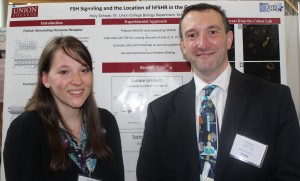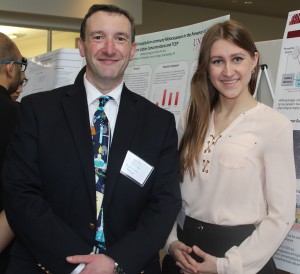Sebastien Gingras
Association of Glucocorticoid Receptor Polymorphisms with Metabolic Characteristics in Bariatric Patients

Cortisol affects target tissues by acting on the glucocorticoid receptor (GR). High cortisol concentrations cause symptoms such as hyperglycemia, hypertension and weight gain, known as Cushings’ Syndrome (CS). Hypersensitivity-causing single-nucleotide polymorphisms (SNPs) of the GR lead to a similar phenotype. Because of this resemblance, we hypothesized that Metabolic Syndrome may be a cushingoid-like state with no hypercortisolemia but with GR hypersensitivity. Additionally, GR SNPs may affect the rate of weight regain following bariatric surgery. We genotyped 59 bariatric patients for the BclI and N363S SNPs using polymerase chain reactions with allele-specific primers, and obtained metabolic data on the patients. One-way ANOVAs using SPSS revealed a significant difference in triglycerides levels between homozygous mutants and heterozygotes for the BclI SNP. All other parameters were non-significant. BclI mutants tended to have higher LDL cholesterol levels and lower HDL cholesterol levels with only slightly higher BMI, and N363S heterozygotes tended to have higher LDL levels, systolic BP and blood glucose than homozygous wild-types. These results show that individuals with GR SNPs have altered metabolic profiles, suggesting that SNPs could contribute to the development of disease states such as Metabolic Syndrome, and affect the success of bariatric surgery.
Timothy Hagan
Investigation of the Caveolin-Human Follicle Stimulating
Hormone Receptor Interaction through Peptide Treatments

Human Follicle Stimulating Hormone (hFSH) plays a role in the regulation of Sertoli cells in males and granulosa cells in females, promoting gametogenesis. hFSH acts through a cell surface receptor on target cells, (hFSHR) that is thought to interact with the membrane protein caveolin. To test the hypothesis that caveolin interacts with a specific sequence in transmembrane domain IV of hFSHR, synthetic peptides that mimic the putative hFSHR-caveolin binding sequence were added to cells expressing hFSHR. It is believed the interaction occurs through this sequence of the receptor due to its aromatic nature. The peptide treatment was expected to decrease signaling from hFSHR as measured by changes in phosphorylation of the p44 MAP kinase and CREB. Western blot analysis of signaling molecule phosphorylation showed a difference between the wildtype and mutant peptide treatments. These results indicate the key interaction between caveolin and hFSHR likely occurs at transmembrane domain IV and may represent an important therapeutic target for regulating hFSHR action.
Katherine Keever
Sugar Consumption Alters Perception of and Response to Stress in Undergraduate Students: Understanding the “Freshman Fifteen”

Psychological stress is a common part in everyday life that directly affects the body through the nervous system and neuroendocrine hormones. Perceived stressors lead to activation of the hypothalamic-pituitary-adrenal (HPA) axis, followed by the synthesis and release of the glucocorticoid hormone cortisol. Studies have linked cortisol release during high-stress periods to increased intake of sugary foods, along with high sugar consumption leading to lower stress and cortisol levels. In this study, undergraduate students’ diets were supplemented with either a high sugar drink or water for one week, and then underwent the Trier Social Stress Test (TSST). Subjects’ perceived stress was measured with the Revised Undergraduate Student Hassle Scale (RUSHS) in academic, social, and personal categories, and saliva samples were collected pre and post TSST to analyze salivary cortisol levels using an enzyme-linked immunosorbent assay (ELISA). Preliminary results have revealed a difference between sugar and water group participants’ perceived stress and baseline cortisol levels, potentially indicating a need for specific stress-reduction interventions for college students to reduce unhealthy stress-induced changes in dietary habits.
Rosiane Lima
Studying the Effects of Introducing Multiple Mutations into the Caveolin Binding Motif of the Human Follicle Stimulating Hormone Receptor (hFSHR)

This study focuses on the hypothesis that signal transduction by hFSHR is regulated by interaction between a membrane protein called caveolin and a specific sequence of hFSHR known as the CBM which has the canonical pattern ΦXΦXXXXΦXXΦ. If this hypothesis is correct, then mutating the CBM will interrupt the interaction between caveolin and hFSHR, inhibiting signal transduction. This would then have negative effects on normal reproduction in both males and females. To make multiple mutations in the CBM, expression plasmids for mutant hFSHR isoforms containing single phenylalanine mutations in the CBM were used as a template for site directed mutagenesis. Using restriction enzyme digestion, we confirmed that we successfully made the double mutants F479L/F481L, F481L/ F486L, and F486L/ F489L. By transfecting the expression plasmids for the double mutants into cells, we can then determine if the mutations alter interaction with caveolin and signaling from the receptors. This could have broad reaching implications for understanding how to regulate fertility by altering the hFSHR-caveolin interaction.
Grace Mirales
Analyzing the Role of Caveolin in Human Follicle Stimulating Hormone Receptor Regulation

The human follicle-stimulating hormone receptor (hFSHR) is a transmembrane G protein-coupled receptor (GPCR); upon human follicle-stimulating hormone (hFSH) binding, activates an intracellulal signaling pathway responsible for the maturation and regulation of the reproductive systems in both females and males. The purpose of the current research was to determine the role of caveolin in regulating hFSHR cell membrane trafficking, internalization, and signal transduction utilizing the dominant negative caveolin 1 S80E mutant (Cav1/S80E). A previously established cell line stably transfected with hFSHR cDNA (HEK293-hFSHR) cells were transiently transfected with plasmids to express wild type caveolin (Cav1/WT) or Cav1/S80E isoform. Separately, transfected cells were treated with hFSH at varying time points from 0-30 minutes and western blotting was used to qualitatively determine the amount of phosphorylated p42/44 (p-p42/44) to measure kinase activation. P-p42/44 was not observed until the 5 minute time point, where both Cav1/S80E and WT had equally upregulated levels of p-p42/44. By 15 minutes of treatment, Cav1/S80E mutant cells still showed a strong p-p42/44 signal whereas the WT began to downregulate p-p42/44. Based on outside literature, we speculate that FSH internalization is partially caveolin mediated and partially clathrin mediated. This new information could help identify novel mechanisms for hFSHR regulation.
David Roy
Cortisol Levels in Response to Induced Stress in Athletes and Non-Athletes

Cortisol is a steroid hormone produced in the adrenal gland as a part of the Hypothalamic-Pituitary (HPA) Axis. This release is by stress and helps increase blood sugar and triggers other responses to help the body cope with the stressful situation. Previous research has shown that stress and cortisol levels play a role in obesity and eating disorders. Furthermore, exercise has been shown to help people with stress. To study the correlation between exercise and cortisol levels, college-age student-athletes were compared to non-athletes. The participants were subjected to the Trier Social Stress Test (TSST) in an attempt to induce stress and subsequently a cortisol spike. Participants’ saliva was collected before, directly after, and 30 minutes after the TSST. Cortisol was measured by ELISA analysis. Participants also rated their perceived stress levels on a ten-point scale before and after the TSST, completed a daily hassles questionnaire (RUSHS), and a food choice questionnaire pre and post TSST. Non-athetes showed significantly higher cortisol levels after the TSST, but slightly lower baseline cortisol levels. Perceived stress was also higher in non-athletes. Together these results suggest that exercise and athletic training may help mitigate the severity of the stress response in college students.
Stan Soroka
Point Mutations of the Putative Follitropin Receptor Caveolin Interaction Motif Do Not Disrupt Receptor Function

Human follicle stimulating hormone (hFSH) is secreted by the anterior pituitary and targets the ovaries and testes. Specificity of targeting is accomplished by the interaction of hFSH with its receptor (hFSHR) on target cells. hFSHR is a G protein-coupled receptor that localizes to domains in the cell membrane known as lipid rafts. The mechanism of translocation of the hFSHR into lipid rafts is unknown. Our hypothesis is that translocation occurs through interaction of hFSHR with the protein caveolin via a specific sequence in the hFSHR; a putative caveolin interaction motif (CIM). The canonical caveolin interaction motif, ΦXΦXXXXΦXXΦ where Φ is any aromatic amino acid such as phenylalanine (F), tyrosine or tryptophan), is found in the fourth transmembrane domain of hFSHR in amino acids 479-489 (FAFAAALFPIF). The goal of the current research is to produce stable cell lines expressing isoforms of hFSHR with one of each of the four phenylalanines mutated to leucine. When the mutant receptors were expressed in cells they qualitatively demonstrated normal FSH responsive signaling. Understanding the caveolin interaction motif of hFSHR could give us better understanding of the mechanism of hFSHR localization to lipid rafts and may give insight into a novel way to regulate hFSHR function.The follicle stimulating hormone receptor (FSHR) is a g protein-coupled receptor found in granulosa cells in the ovary. FSHR activation by FSH leads to proliferation and maturation of ovarian follicles towards ovulation; understanding this pathway could lead to developments in regulating fertility. Previously, our lab studied FSHR using an HEK293 cell line stably transfected with FSHR cDNA. More recently we have investigated an immortalized human granulosa cell line (hGrC1) to study FSHR signaling in a more physiologically relevant context. The stage of follicular development represented by the hGrC1 cells is currently not known. Based on previous data from our lab, the question arose of whether hGrC1 cells undergo developmental changes in culture analogous to follicular maturation in vivo. hGrC1 cells were grown in culture for a variable number of days before treatment with FSH. To measure FSH signaling the presence of phospho-CREB and phospho-p44 were determined by western blot. Both pathways were increased after cells were treated 4 days post-confluency, consistent with a developmental shift leading to more hFSHR protein the longer the cells were grown in culture. This suggests that hGrC1 cells mimic granulosa cell differentiation in vitro and may be a viable model for understanding
Research Practicum Students
Holly Schwab ’16
FSH Signaling and the Location of hFSHR in the Cell Membrane

Follicle-stimulating hormone (FSH) is important in regulating reproduction by stimulating sperm development by Sertoli cells in males and follicle development in the ovaries of females. The functioning of this hormone is based upon interaction with its receptor, hFSHR (human follicle stimulating hormone receptor), which is a g protein-coupled receptor located in the cell membrane. Previous work has demonstrated the positioning of hFSHR in membrane microdomains called lipid rafts. The presence of the hFSHR in lipid rafts is hypothesized to play a role in the signaling of FSH. Here we show the effect of adding FSH to HEK293 cells stably expressing the hFSHR (HEK293-hFSHR) to determine the impact of hormone binding on the location of the FSH receptor in the cell membrane. HEK293-hFSHR cells were treated with FSH for varying amounts of time and then fractionated on sucrose gradients to separate lipid rafts from the rest of the membrane. Western blot analysis of the resulting fractions revealed that hFSH treatment caused hFSHR to temporarily leave the lipid rafts and then return over the duration of the hormone treatment. Uncovering the location of hFSHR in the cell membrane related to signaling of FSH has practical implications related to contraception and fertility.
Scholars Research Students
Vera Marsova
AFM Characterization of Human Granulosa Cells

For a long time, endocrinology has focused on biochemical and molecular biological aspects of hormone signaling. However, there is a growing body of evidence indicating the importance of physical cues to the morphology, physiology and pathology of the endocrine system. In our study, we utilized atomic force microscopy (AFM) to examine a human granulosa cell line (hGrC1) as model for granulosa cells from the ovary. Investigating these cells will give insight into follicle stimulating hormone receptor function in particular and reproductive function in general. The objective of this work is to map granulosa cells as a first step towards characterizing cell membrane stiffness, lipid rafts and FSH receptor proteins. To date, we have acquired reliable topographical data of the hGrC1 cell line and done preliminary elasticity measurement studies. Our next step is to further evaluate mechanical parameters of granulosa cells and to generate antibody modified tips for FSHR recognition as a way of quantifying the density, spatial organization, and magnitude of binding of the FSH receptor on live hGrC1 cells.

You must be logged in to post a comment.